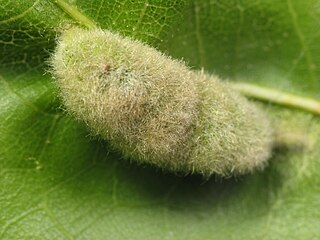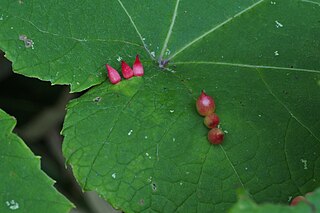
Ampelomyia viticola, the grape tube gallmaker, is a species of gall midge found in the eastern United States and Canada. It produces green or bright red galls on new world grape vines.

Schizomyia is a genus of gall midges. It has a cosmopolitan distribution.

Asphondylia is a cosmopolitan genus of gall midges in the family Cecidomyiidae. All species in this genus induce galls on plants, especially on flowers and flower buds. There are over 300 described species in Asphondylia, with many more likely to be discovered and described, especially in the southern hemisphere.

Asphondyliini is a tribe of gall midges in the family Cecidomyiidae. There are about six genera and at least 100 described species in Asphondyliini.

Caryomyia is a genus of hickory gall midges in the family Cecidomyiidae. They are often known as the hickory gall midges since most species feed on various species of hickory. There are at least 30 described species in Caryomyia.
Polystepha is a genus of gall midges in the family Cecidomyiidae. There are more than 20 described species in Polystepha.

Macrodiplosis is a genus of gall midges, insects in the family Cecidomyiidae. There are about 19 described species in Macrodiplosis.

Asphondylia rudbeckiaeconspicua is a species of gall midges in the family Cecidomyiidae. The larvae induce galls on Rudbeckia laciniata in North America. It was first described by Carl Robert Osten-Sacken in 1878.
Astictoneura is a genus of gall midges in the family Cecidomyiidae. There are at least two described species in Astictoneura.

Asteromyia is a genus of gall midges in the family Cecidomyiidae. There are about nine described species in Asteromyia.

Schizomyia impatientis is a species of fly in the family Cecidomyiidae. This gall midge species induces galls on jewelweeds in eastern North America. It was first described by Carl Robert Osten-Sacken in 1862.

Ampelomyia vitiscoryloides, the grape filbert gall midge, is a species of gall midge in the family Cecidomyiidae. It induces galls on grape plants and is widespread in eastern North America. It was first described by Alpheus Spring Packard in 1869.
Resseliella is a genus of gall midges in the family Cecidomyiidae. There are at least 50 described species in Resseliella.

Schizomyia racemicola is a species of fly in the family Cecidomyiidae. This gall midge species induces galls on goldenrods in eastern North America. It was first described by Carl Robert Osten-Sacken in 1862.

Ampelomyia vitispomum is a species of gall midge in the family Cecidomyiidae. It induces galls on grape plants in eastern North America. It was first described by Carl Robert Osten-Sacken in 1878.
Acericecis is a genus of gall midges in the family Cecidomyiidae. There are at least three described species in Acericecis.
Daphnephila is a genus of gall midge that appears in the Palearctic and Oriental biogeographic realms. Daphnephila species create leaf and stem galls on species of laurel plants, particularly in Machilus. Based on analysis on sequences of the mitochondrial cytochrome c oxidase subunit I, it has been suggested that in this genus, the stem-galling habit is a more ancestral state as opposed to the leaf-galling habit.

Harmandiola is a genus of flies belonging to the family Cecidomyiidae. The 14 described species are found in the Holarctic region. They induces galls on Populus, Castanea, and Carya.
Massalongia is a genus of flies in the family Cecidomyiidae. The larvae induce galls on birches.

Ampelomyia conicocoricis is a species of fly in the family Cecidomyiidae. It induces galls on grape plants in Japan. This is the type species for the genus.














